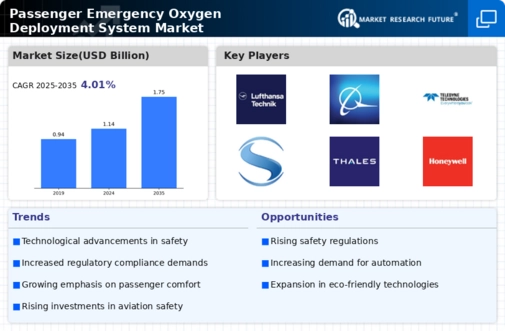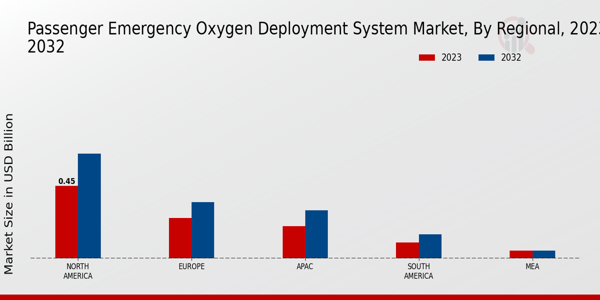Market Growth Projections
The Global Passenger Emergency Oxygen Deployment System Market Industry is projected to experience substantial growth over the next decade. With a market value of 1.14 USD Billion in 2024, the industry is expected to reach 1.75 USD Billion by 2035. This growth trajectory indicates a compound annual growth rate (CAGR) of 3.96% from 2025 to 2035, driven by factors such as increasing air travel demand, regulatory compliance, and technological advancements. These projections highlight the evolving landscape of the industry and the importance of emergency oxygen systems in ensuring passenger safety.
Increasing Air Travel Demand
The Global Passenger Emergency Oxygen Deployment System Market Industry is poised for growth due to the rising demand for air travel. As global passenger numbers are projected to reach 4.5 billion in 2024, airlines are compelled to enhance safety measures, including emergency oxygen systems. This demand is further fueled by the increasing number of aircraft deliveries, which are expected to exceed 39,000 by 2035. Consequently, the market for passenger emergency oxygen systems is anticipated to expand, with a projected value of 1.14 USD Billion in 2024, reflecting the industry's commitment to passenger safety.
Emerging Markets and Regional Expansion
The Global Passenger Emergency Oxygen Deployment System Market Industry is witnessing growth in emerging markets, where air travel is becoming more accessible. Regions such as Asia-Pacific and Latin America are experiencing rapid increases in air traffic, prompting airlines to invest in safety measures, including emergency oxygen systems. The expansion of low-cost carriers in these regions further accelerates the demand for compliant safety equipment. As these markets mature, the overall market is expected to grow, with projections indicating a value of 1.75 USD Billion by 2035, reflecting the potential of regional expansion in driving industry growth.
Focus on Passenger Safety and Experience
The emphasis on passenger safety and overall experience is a critical driver for the Global Passenger Emergency Oxygen Deployment System Market Industry. Airlines are increasingly prioritizing safety measures to build customer trust and loyalty. Enhanced emergency oxygen systems not only comply with regulations but also serve as a reassurance to passengers. Airlines that invest in advanced safety technologies are likely to differentiate themselves in a competitive market. This focus on safety is expected to contribute to the market's growth, with a projected value of 1.14 USD Billion in 2024, highlighting the industry's commitment to improving passenger safety.
Regulatory Compliance and Safety Standards
Regulatory bodies worldwide impose stringent safety regulations that airlines must adhere to, thereby driving the Global Passenger Emergency Oxygen Deployment System Market Industry. The International Civil Aviation Organization (ICAO) mandates that all commercial aircraft be equipped with emergency oxygen systems. Compliance with these regulations not only ensures passenger safety but also enhances the operational credibility of airlines. As a result, the market is expected to grow, with a projected value of 1.75 USD Billion by 2035, illustrating the importance of regulatory frameworks in shaping industry dynamics.
Technological Advancements in Oxygen Systems
Innovations in technology are significantly influencing the Global Passenger Emergency Oxygen Deployment System Market Industry. The development of lightweight, compact, and efficient oxygen delivery systems enhances the overall passenger experience during emergencies. For instance, advancements in oxygen generation systems and deployment mechanisms have improved reliability and reduced maintenance costs. These technological improvements are likely to attract investments and drive market growth, as airlines seek to upgrade their fleets with state-of-the-art safety equipment. The anticipated CAGR of 3.96% from 2025 to 2035 underscores the potential for sustained growth in this sector.





















